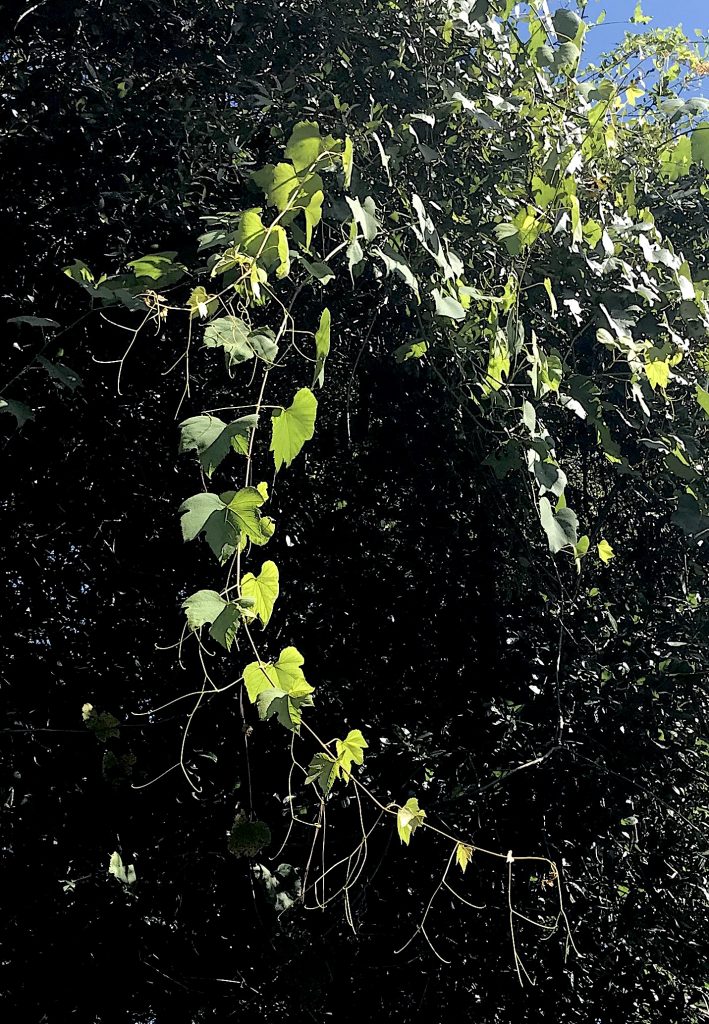
A good example of forked-tendril grapes in this case in Gainesville. To read more about grapes go here.
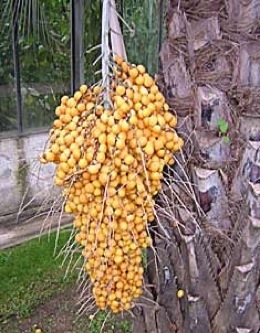
Pindo palm fruit is hard to resist.
July is passing and that means many different things to foragers depending upon your location on the rotation. In a particular latitudinal belt around the world it means the Pindo Palms are in fruit — my favorite after coconut which also fruit in south Florida. And don’t think Pindo Palms are just a warm region plant. They grow as far north as Washington DC and elsewhere in under protection. Also call the Jelly Palm, they were standard landscaping for every southern home because you can make a jelly from the fruit without having to add any pectin or sugar. However, just as year-to-year production of herbal medicinals change with the weather so does the quality of the pindo jelly. It has vintages. Some years you will have to add a little sugar, other years some pectin. But most years it is just right. I also like to eat the fruit right off the palm. I enjoy the pulp and spit out the fiber. Some folks just eat all the fiber and pulp. The seed kernel even has a good cooking oil in it. Pindo wine is always cloudy, though, because of the pectin, but after 14 glasses you don’t notice.
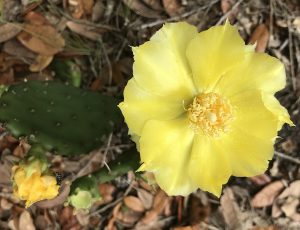
Opuntias are blossoming now. They can also have pink blossoms. Photo by Green Deane
Folks also think cactus, like palms, are warm weather residents. In fact, cactus are native to 46 of the 50 US states and naturalized in one of those four (Hawaii.) The only states they are not native in other than Hawaii are Maine, New Hampshire and Vermont — the farthest away from their origin in central America. That said, I knew where there were some surviving cactus behind an old homestead in Maine. They looked quite ratty every spring but somehow managed to survive. Cactus have been naturalized in many parts of the world. Malta comes to mind where they are living fences and a “traditional” source of wine and spirits even though they are native to Mexico and south.

Classes are held rain or shine or cold. (Hurricanes are an exception.) Photo by Kelly Fagan.
Foraging classes this week include both coasts. Eagle Lake Park used to be a working farm. And Wickham Park (and Wickham Road) are named for a fellow I knew, county commissioner Joe Wickham. Before WWII he was responsible for surveying most of the major roads in the county.
Saturday, July 25th, Eagle Lake Park, 1800 Keene Road, Largo, FL 33771. Meet at the pavilion near the dog park. 9 a.m. to noon.
Sunday, July 26th, Wickham Park: 2500 Parkway Drive, Melbourne, FL 32935-2335. Meet at the “dog park” inside the park. 9 a.m. to noon.
Sunday, August 2nd, Mead Garden: 1500 S. Denning Dr., Winter Park, FL 32789. 9 a.m. to noon. The entrance is on the west side of Denning. Some GPS maps put it wrongly on the east side off Pennsylvania.
Sunday, August 9th, Ft. Desoto Park, 3500 Pinellas Bayway S. St. Petersburg Fl 33715. There is an entrance fee to the park. Meet at the fishing pier parking lot. 9 a.m to noon. (Same pier as the ferry.)
For more information about the classes, to pre-pay, or sign up go here.
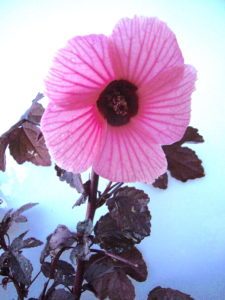
The blossom and leaves are edible on the False Roselle. Photo by Green Deane
A species responding to the warmer and wetter weather is the False Roselle. It grows “wild” in my back yard. I noticed this past week seedlings coming up. To the eyes of anyone who looked at plants in a northern climate ones first guess on seeing the False Roselle is that it is a misplaced Red Maple. The resemblance is superficial but close enough to give one pause. Though I would not label the tree with a Pampered Chef epitaph but to me the leaves say “Salads and Stir Frys. Its purple leaves — true purple, not the reddish green of the true Roselle — are tart and just rightly so. They go into salads well. More so, they take to quick vegetable-lush stir fries and do not lose their color or taste on cooking. It’s even a good tree to nibble on wherever you find it. The species, interestingly, is not long-lived, a few years at best like Elderberry. But it spreads easily and can be grown from seeds or better from shoots. Just cut off a few young branches, take off the lower leaves, put the stems in water and within a couple of weeks you will have well-rooted twigs to plant. In fact I over-winter some every year. A heavy frost or a light freeze will die them back to the roots. Young trees will come back in the spring, but often older plants won’t. So I raise a few in the winter to make sure I can restock in the summer. The blossoms are edible as well and a juice can be made from the caylexs. Red Maple are more iffy. Red Maple leaves are bitter but humans can eat a few of them. However, Red Maple leaves are deadly to horses and they will eat them. Keep your horses away from Red Maples. You can read about the False Roselle here
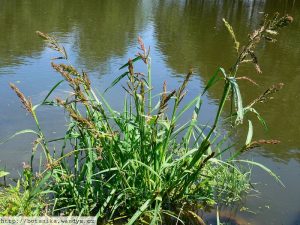
Barnyard Grass is the most misnamed grass in the world.
One would think that with a name like “Barnyard Grass” one would find it in barnyards. But no. It is probably safe to say you will rarely find Barnyard Grass in a barnyard. Why? Because Barnyard Grass likes to grow in water, lots of water. You can easily find it in ponds, streams and drainage ditches but not barnyards unless it is growing directly under the roof drain spout in a very low, wet spot. In all my years of foraging I have seen Barnyard Grass once in a barnyard but dozens of times in water. In wet areas look for a tall grass that resembles wheat. The stems will be hairy and usually purple at the base. One easy place to find them locally is in dried up lakes. Often at the still-damp low spot Barnyard Grass will colonize the entire low spot. Not a native it comes in season at the same time and one can find it seeding now. The grain is a bit more coarse than wheat but can be harvested, prepared and used the same way. You can read about Barnyard Grass here.
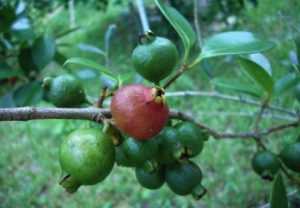
You want pink and green strawberry guava. Photo by Green Deane
Nearing the end of its fruiting season is a species that is very invasive in some areas: The Strawberry Guava. During the foraging class this past Saturday we spent time walking through a local neighborhood. We found edibles, among them three Cinnamon Trees, Society Garlic, Cocoplums and the Strawberry Guava. I had a Strawberry Guava in my yard for about 15 years. Not only are the fruit edible but the dried leaves can be made into a passable tea. One does, however, need to know a little about the species to make the most of the fruit. It’s a little smaller than a ping-pong ball, has tough seeds, and starts out green and hard. As it ripens and softens it will get shades of pink, yellow and red and eventually become dark red and soft, hence the name “Strawberry Guava.” The fruit is tart and sweet, more tart when young, more sweet when older. Despite the name I never tasted a strawberry flavor in any of the fruit. The problem is unless you spray the tree with insecticides the ripe fruit will be full of fly larvae (which you can also view as free protein.) When the fruit is just starting to turn from green to red the rind is too hard for the flies to lay eggs through. But by the time they are soft and ripe they are prime breeding ground. Thus you have a choice, slightly ripe and tart but bug free, or, very ripe and sweet and squirming. To read more about the Strawberry Guava go here.

Green Deane videos are now available on a USB.
Changing foraging videos: My nine-DVD set of 135 videos has been selling for seven years and are still available. They are the same videos I have on You Tube. Some people like to have a separate copy. A second option is a16-gig USB that has those 135 videos plus 15 more. While the videos can be run from the DVDs the videos on the USB have to be copied to your computer to play. They are MP4 files. The150-video USB is $99 and the 135-video DVD set is now $99. The DVDs will be sold until they run out then will be exclusively replaced by the USB. This is a change I’ve been trying to make for several years. So if you have been wanting the 135-video DVD set order it now as the price is reduced and the supply limited. Or you can order the USB. My headache is getting my WordPress Order page changed to reflect these changes. We’ve been working on it for over three weeks. However, if you want to order now either the USB or the DVD set make a $99 “donation” using the link at the bottom of this page or here. That order form provides me with your address, the amount — $99 — tells me it is not a donation and in the note say if you want the DVD set or the USB.

Green Deane Forum
Want to identify a plant? Perhaps you’re looking for a foraging reference? You might have a UFO, an Unidentified Flowering Object, you want identified. On the Green Deane Forum we — including Green Deane and others from around the world — chat about foraging all year. And it’s not just about warm-weather plants or just North American flora. Many nations share common weeds so there’s a lot to talk. There’s also more than weeds. The reference section has information for foraging around the world. There are also articles on food preservation, and forgotten skills from making bows to fermenting food.
This is weekly newsletter #415, If you want to subscribe to this free newsletter you can find the sign-up form in the menu at the top of the page.
To donate to the Green Deane Newsletter click here.

